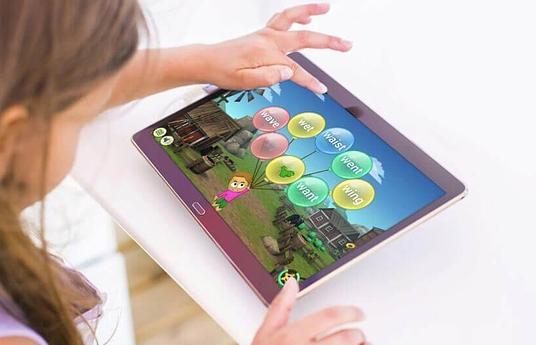Access to quality education is a major challenge for children with disabilities due to inaccessible facilities, inflexible curricula, and a lack of assistive devices and learning materials. These barriers result in low enrollment, high dropout rates, and limited academic potential. However, the UNICEF Accessible Digital Textbooks (ADT) Initiative aims to overcome these challenges by promoting inclusive education.
The project stands as a testament to innovation by recognizing the diverse learning needs of students and embracing open-source technology and UDL principles. Through the development of ADTs, the project revolutionizes traditional education by offering a wide array of customization options such as narration, sign language videos, interactive elements, simplified language, and audio descriptions of images. These innovative features cater to different learning preferences, and accessibility needs, ensuring that all students can engage with educational content in a way that best suits them.
ADTs not only break down barriers that previously hindered students with visual, hearing, intellectual, developmental, and learning disabilities but also cater to those who prefer receiving information differently. By leveraging technology, ADTs transform inaccessible printed books into fully accessible learning resources, empowering students with disabilities to access adapted content effortlessly and on equal footing with their peers.
The ADT initiative not only improves access to textbooks and storybooks but also follows Universal Design for Learning (UDL) principles, providing customized learning experiences for all children, including those with disabilities. ADTs are digital, accessible, and versatile, allowing users to customize features like narration, sign language video, interactivity, simplified language, and audio-description of images to suit different learning needs and preferences. They can also include interactive exercises aligned with UDL principles. ADTs are typically in EPUB3 format and require installation on electronic devices like tablets, computers, or smartphones. Alternatively, they can be downloaded from a content access point or district server with an internet connection. Once installed, learners can use the textbook offline on their devices.
The ADT initiative brings together stakeholders such as writers, publishers, teachers, organizations of persons with disabilities, and ministries of education to strengthen the production of accessible digital materials. The goal is to ensure equal access to affordable digital textbooks for all learners, including those with disabilities.
Several pilot experiences have been conducted (Dominican Republic, Colombia, Jamaica, Nicaragua, Paraguay, and Uruguay, Bhutan and Nepal) and currently, one pilot is being conducted in Uruguay, where the first AI-led ADT has been developed.
ADTs are currently developed and available in eleven countries within three regions:
-Latin America and the Carribean (LAC): Colombia, Dominican Republic, Jamaica, Nicaragua, Paraguay, Uruguay.
-Eastern and Southern Africa (ESAR): Kenya, Rwanda, and Uganda.
-South Asia (Nepal and Bhutan).
Globally, 64 ADT prototypes have been produced. In the past three years, the ADT initiative has experienced remarkable growth. LAC received substantial support, expanding the initiative to six countries piloting over 25 ADTs. Strong partnerships with publishers and technology developers, along with regional cooperation, contributed to this expansion. Colombia and Paraguay developed online courses on Universal Design for Learning (UDL) and ADT usage. Various communication products have been produced. ADTs now offer multiple formats (Epub, HTML and Apps), and Rwanda made the entire curriculum (55 ADTs) accessible through the education cloud. Other countries, such as Equatorial Guinea, El Salvador, Peru, and Maldives, among others, have shown interest in learning from the ADT experience in other countries before developing their own prototypes. This progress signifies a shift towards inclusive education globally.
In 2024, UNICEF began collaborating with OpenAI to co-develop an AI-powered pipeline aimed at streamlining and largely automating the production of accessible digital textbooks (ADTs) and storybooks from print sources. The partnership was officially announced at the Global Disability Summit in April 2025. This innovation significantly reduces the time, human resources, and costs traditionally involved in the production process.
Producing ADTs has historically been an expensive and time-consuming task, typically taking 6 to 9 months and costing between 20k and 50k USD per ADT. These figures are based on UNICEF’s extensive experience working with governments and experts in producing these materials. To accelerate this process, lower costs, and introduce new accessibility features, UNICEF developed an AI tool capable of fully automating the creation of interactive digital textbooks or storybooks from static documents such as PDFs.
The new AI pipeline has been piloted in Uruguay. It has demonstrated a significant decrease in the time and cost of production of ADTs developed using the AI pipeline, taking production time from months to days. Although, like previous ADTs not produced using AI, there will still be a human quality assurance layer to ensure the high-quality output and address any errors introduced by the AI. Currently, storybooks achieve the highest accuracy, scoring over 80 percent across conversion types.
You can access the ADTs produced through the links below:
https://www.accessibletextbooksforall.org/explore-accessible-digital-textbooks
https://www.bookfusion.com/libraries/MOEYI/lists/Accessible%20Digital%20Textbooks%20(ADTs)?fbclid=PAQ0xDSwJ4mNpleHRuA2FlbQIxMAABp9y3kHgMSY4EZl3aq1xBRIA8Rya9mFiXpmG8aRSljeXgR4Btz1bOOB1-IY03_aem_NVh6Ys5IGUH7VxnzNUXybwhttps://www.bookfusion.com/libraries/MOEYI/lists/Accessible%20Digital%20Textbooks%20(ADTs)?fbclid=PAQ0xDSwJ4mNpleHRuA2FlbQIxMAABp9y3kHgMSY4EZl3aq1xBRIA8Rya9mFiXpmG8aRSljeXgR4Btz1bOOB1-IY03_aem_NVh6Ys5IGUH7VxnzNUXybw


